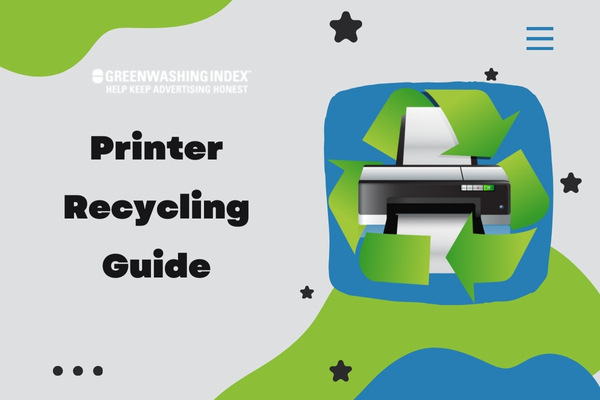Are you tired of not knowing what to do with your old printers? Wondering how you can make a difference for the planet without much fuss? I’ve got your back! In this guide, I’ll walk you through printer recycling in a way that’s easy to grasp. Imagine giving your trusty office buddy a new lease on life, all while doing right by Mother Earth—exciting, isn’t it?
Printer recycling doesn’t have to be complicated. In fact, it’s a simple process that anyone can do. All you need is some know-how and the right place to take your printer. When it’s time for your device to retire, recycling helps reduce e-waste and keeps harmful materials out of our environment. This creates more room for us and our children to enjoy a cleaner world.
What You’ll Learn Here:
- How tossing old printers can hurt us
- Prepping your printer for its next adventure
- Where to bring printers for sustainable goodbye
- Keeping those cartridge buddies kicking longer
- Smooth steps for cartridges’ final journey
- Dodging common recycling roadblocks with ease
- Tech fixes making eco-printing a snap
- Navigating legalities like an e-waste pro
The Importance of Printer Recycling
Printer recycling is something I take to heart because it’s more than just dealing with old gadgets. So, why recycle printers? Imagine this: every printer that’s thrown away could end up in a landfill. That’s a lot of waste piling up, right? But when we recycle these machines, we do something good for the planet. Let me break it down:
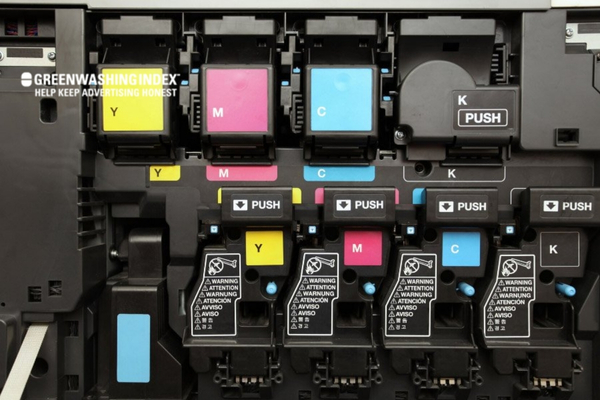
- Conserving Resources: Printers have all sorts of materials – metals, and plastics, which can be used again. This saves raw materials from being taken from nature.
- Reducing Pollution: Making new printers needs energy and creates pollution. If you reuse parts from old printers, there’s less need to make new ones and, therefore, less pollution.
- Saving Space: Landfills are no joke; they’re already overflowing with trash! Recycle your printer, and you’re making sure it doesn’t add to that growing pile.
Now imagine if everyone recycled their printers – how much good would that do for our planet?
The Environmental Impact of Printer Waste
You toss out an old printer; it seems harmless enough, but let me paint a clearer picture of what happens next.
- Harmful Chemicals: Printers aren’t just plastic boxes; they can contain harmful substances like mercury or lead. When these chemicals leak into the soil or waterways, they can hurt plants and animals and even get into our food and water!
- Energy Wastage: Think about all the power used to craft each part of a printer. That energy goes to waste when the printers are dumped. But if we recycle, we keep those resources in use!
- Landfill Overload: Space on Earth isn’t endless! When non-recyclable waste fills landfills, well… there’s simply no more room for anything else!
So what happens if we just ignore those piles of discarded electronics? We risk harming wildlife, people’s health through water contamination and overcrowding landfills which could otherwise be avoided by eco-friendly solutions like printer recycling.
Also Read: Paint Recycling: The Ultimate Guide to Responsible Disposal
Steps to Effective Printer Recycling
Recycling your printer is important for the environment. It helps reduce waste and saves resources. To recycle a printer effectively, there are steps you should take to make sure it’s done right.
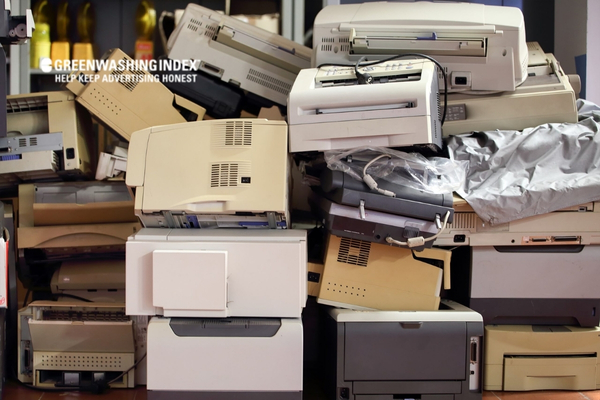
Preparing Your Printer for Recycling
When you decide it’s time to recycle your old printer, follow these steps carefully:
- Check the Printer Manual: Before you do anything, see if there is a recycling or disposal guide in the manual that comes with your printer.
- Remove Cartridges: Take out any ink or toner cartridges from the printer. Cartridges should be recycled separately because they often contain materials that can be reused.
- Clear Personal Data: If your printer has a memory for storing documents, make sure to erase this data.
- For printers with a screen: Navigate through the menu options; look for settings that say ‘Restore Factory Settings’ or ‘Reset’.
- For printers without a screen: You might need to press and hold specific buttons on the printer to reset it (check your manual).
- Unplug Accessories: Disconnect cables like power cords or USB connectors.
- Clean Up: Gently clean off any dust or residue from outside of the printer so it doesn’t get into recycling machines.
- Pack Properly: If possible, pack the printer back into its original box; if not, use another box and cushioning materials to avoid damage during transportation.
Remember that different parts of your old equipment can be taken apart and recycled in different ways!
Finding Suitable Facilities for Printer Recycling
Now let me tell you how to find places where you can take your old printers for recycling:
- Research Online:
- Start by running an internet search with terms like “printer recycling near me” or “electronics recycling drop-off.”
- Check Manufacturer Programs:
- Many companies have their own take-back programs where they collect old devices.
- Visit Local Waste Centers:
- Your town’s waste collection center might accept electronics.
- Look at Retailers:
- Some stores offer electronic recycling services as well, especially those selling electronics.
- Make sure before you choose somewhere – check what kinds of items they accept!
- Call ahead or visit their website just to double-check.
- Consider Non-profits and Schools: Sometimes, these places run collection drives, too!
- Condition is Key: If your machine still works – some places prefer accepting them over broken ones since they can refurbish and resell them.
By following these detailed steps on how I prepare my printers for eco-friendly recycling, we all contribute towards sustainable printing practices! Remember – effective e-waste management starts with each one of us making little efforts like this one at home before searching out proper electronics recycling facilities!
Also Read: Mattress Disposal: Easy Steps for Eco-Friendly Solutions
Best Practices in Printer Cartridge Management
Managing your printer cartridges is more than just about saving money; it’s a vital part of e-waste management. By taking good care of them, we contribute to eco-friendly printing and sustainable printing practices.
Extending Cartridge Life Before Recycling
When it comes to printer recycling and sustainable printing, one key aspect is managing your printer cartridges well. This means making sure they last as long as possible before they need to be recycled. Here’s how you can extend the life of your printer cartridges:
- Use draft mode: When you’re printing something that doesn’t need to be high quality, like a rough draft or notes for personal use, set your printer to ‘draft mode’. This uses less ink.
- Print only what you need: Think before you print. If you only need a section of a document, print just that part instead of the whole thing.
- Keep cartridges clean: Sometimes, ink nozzles on cartridges get blocked. Cleaning them gently with a soft cloth can help ink flow better.
- Avoid dry-out: Ink can dry out if you don’t use your printer often. Try to print something once every week or so to keep the ink moving.
- Refill cartridges: Instead of buying a new cartridge every time, consider getting it refilled. Many stores offer this service.
Extending life helps not just with eco-friendly printing but also with e-waste management by reducing waste overall.
The Right Way to Recycle Printer Cartridges
Now, when it does come time to recycle those printer cartridges – and eventually, it will – make sure you’re doing it right:
- Return them to the manufacturer: Some companies have their own recycling programs for used cartridges. They usually provide instructions and sometimes even postage-paid envelopes or labels for shipping.
- Drop them off at special bins or centers: Many office supply stores have drop-off points specifically for used electronics and cartridges.
- Use local e-waste collection services: Check if your community has electronics recycling collection events or centers that accept printer cartridges.
Remember in all this: correct recycling ensures that none of those potential pollutants from electronics end up harming our environment. It’s part of smart e-waste management and is crucial for sustainable printing and keeping our planet healthy.
Printer recycling is an important task we should all take seriously – both in how we use items like printer cartridges day-to-day and how we dispose of them when they’re spent. These tips are here so anyone can follow along easily; I hope they help make managing printers at home or work more eco-friendly!
Also Read: Old Electronics Disposal: Ultimate Recycling Tips Guide
Overcoming Challenges in Printer Recycling
When it comes to printer recycling, I’ve seen quite a few hurdles that make things tough. Let’s break them down and talk about how we can jump over these obstacles.
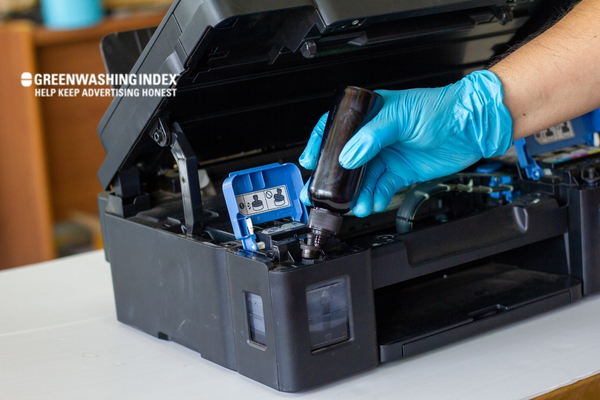
Common Obstacles When Recycling Printers
Printer recycling can be tricky, but I know we can sort it out. Let me walk through the issues and how to beat them:
1. Knowing What’s Inside: Printers have bits that are tough to recycle. There’s plastic, metal, and sometimes even harmful stuff. The fix? Get experts who know what they’re doing to take apart the printer safely.
2. Finding a Place: Not every recycler takes printers. But don’t worry! You just have to look for a dedicated electronics recycling center or a community e-waste program that accepts them.
3. Data Security: Some printers store what you’ve printed. Yikes! Before recycling, make sure you or an expert wipes this data clean.
4. Costs: Yes, sometimes there’s a fee for recycling printers properly. Think of it as paying forward for our planet’s future; it’s worth it!
5. Awareness Level: Many folks just don’t know how important printer recycling is or how to do it right.
To beat these challenges:
- Share info on social media or in your community about where and why to recycle printers.
- Put up signs in offices reminding everyone that printers shouldn’t end up in the trash.
- Ask local businesses if they need help recycling their old equipment—sometimes, they just need a nudge!
Innovations in Promoting Sustainable Printing Solutions
Now let’s light up some cool new ways people are making printer recycling easier and earth-friendlier:
1) Smart Design: Newer printers are made with less stuff that harms the environment and is easier to take apart when they’re old news.
2) Trade-In Programs: Say you’ve got an old printer; some companies might let you trade it for a discount on a new one—nice, right?
3) Printer Leasing: This is like renting but cooler because when you’re done with the printer, the company takes care of all the recycling fuss.
The takeaway: Printer recycling has its bumps, but with know-how and innovation, we’re getting much better at keeping our tech habits green!
Also Read: Silicone Biodegradability: Savior or Eco-Foe Mystery?
Legal Aspects and Regulations Surrounding E-Waste
When I think about the legality of e-waste management, one term always comes to mind: “compliance.” It’s essential for everyone, especially businesses, to understand and adhere to the various laws when dealing with printer recycling.
Understanding E-Waste Laws Related to Printers
When I think of printer recycling, I often start with the rules that we all have to follow. E-waste laws can be quite a handful, so let’s break it down.
First off, many places have rules saying you can’t just toss out old electronics with normal trash. Depending on where you live, there might be local city laws or even bigger state and federal regulations keeping an eye on how we get rid of e-waste like printers.
Here’s a basic list of what you might find:
- Local Laws: Cities or counties sometimes have special programs or rules for e-waste. They may have specific drop-off events for electronics or designated areas where you can take your old printers.
- State Regulations: Many states in the U.S., for example, might require manufacturers to run recycling programs. They may also ban certain toxic materials found in printers from landfills.
- Federal Guidelines: On top of local and state rules, there may be broader laws that cover the whole country about how e-waste should be handled.
It’s smart to check with your local waste management services to get the full story on what laws and guidelines apply when it comes to getting rid of your outdated or broken printer.
How Businesses Can Ensure Compliance in Disposing of Old Printers?
Now, if you’re running a business, staying within the lines of these laws is super important and good for your wallet if done right.
In order to do this right, consider these steps:
- Learn Your Local Rules: Knowledge is key! Always make sure you know the latest regulations in your area.
- Partner With Certified Recyclers: Look for certified electronic recyclers who know all about handling e-waste responsibly.
- Create a Recycling Policy: Have clear instructions for your team on how they should get rid of old printers according to the law.
- Educate Your Staff: Make everyone aware of why it’s important and how it helps not just comply with rules but also help our Earth!
- Keep Records: Write down details whenever you recycle a printer—when it was done, who took it away—just so you’re ready if anyone asks.
- Investigate Takeback Programs: Some printer manufacturers offer programs where they take back their own products at their end-of-life stage for no cost or even give discounts on future purchases!
- Plan Ahead: When buying new printers, think ahead about buying ones that are easier to recycle so that when the time comes, things go smoothly.
Following these steps carefully and consistently in mind with cost-effective solutions like takeback programs while choosing easily recyclable models will keep both compliance officers off your back as well as contribute towards sustainable printing practices!
Also Read: Cell Phone Recycling: How to Handle Your Outdated Devices
Corporate Responsibility & Sustainability Initiatives
In today’s world, companies are not just about making money. They have a role to play in looking after our planet. This means they need to think about how their business impacts the environment. A big part of this is how they deal with old printers when they’re not needed anymore. This is where printer recycling comes in.
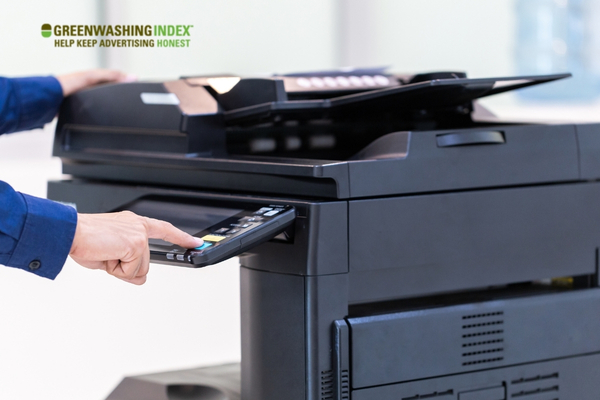
Role of Companies in Encouraging Printer Recycling
Companies have a big job when it comes to printer recycling. They can make a difference by setting up ways for people to recycle and by showing them why it’s important. Let me share some ways companies do this:
- Making Policies Clear: Companies can create rules that say how old printers should be thrown away in the right way.
- Incentives for Recycling: Sometimes, businesses give people a little reward, like a discount on their next purchase, if they bring back their old printer to be recycled.
- Educating Customers: If people know more about why printer recycling is good for the Earth, they might be more likely to do it. Companies can teach their customers through their websites or when they sell them a new printer.
- Partnerships with Recycling Centers: Some companies work together with places that handle e-waste management so that printers are taken apart safely and reused if possible.
- Designing Printers With Recycling in Mind: Smart companies think about printer recycling even when they’re making new printers. They make them easy to take apart so parts can be used again.
By doing these things, companies help make sure we look after our planet better. When businesses focus on sustainable printing and eco-friendly practices, we all win – we get to use cool gadgets without hurting the Earth too much.
Remember this, though: It’s not just about what businesses do; every person who uses a printer has the power to make choices that help our world, too!
FAQs
What parts of a printer are recyclable?
Many parts of a printer, such as the metal components, plastic casing, and circuit boards, are recyclable. Don’t forget about recycling paper trays and ink cartridges!
Can ink cartridges from my home/office printers be refilled instead?
Yes, many ink cartridges can be refilled. It’s a great way to save money and reduce waste. Simply take them to a local refill service or do it yourself with a refill kit.
Are there any incentives or programs available that reward me when I recycle my old equipment?
Indeed, some companies offer discounts or credit when you bring in old printers for recycling. Local governments may also provide perks for participating in their e-waste management programs.
Conclusion
As we wrap up, it’s clear that printer recycling plays a crucial part in our quest for a greener planet. The simple act of responsibly disposing of old printers can have profound environmental benefits. By embracing sustainable printing and e-waste management practices, each one of us can contribute to a future where technology and ecology exist in harmony.
Key Takeaway Points
- Recycling printers is vital to reducing harmful e-waste.
- Preparing your printer properly can streamline the recycling process.
- Finding appropriate facilities is essential for effective electronics recycling.
- Extending the life of printer cartridges is both economically and environmentally beneficial.
- Adhering to e-waste laws ensures legal compliance and promotes corporate responsibility.

